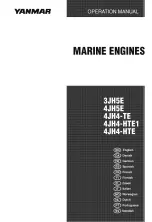
21.2.2 Maintenance
Normally, the main starting valve requires little maintenance. In
case it is to be opened for inspection:
1 Remove the valve
from the engine by loosening the
starting air pipe, the pipe from the valve to the start blocking
valve and the bracket with the starting lever. On V-engines,
also remove the pressure gauge pipes from the instrument
panel and, as a unit, the instrument panel and the bracket with
starting lever. The valve can now be removed from the end
cover.
2 Open the plug (10),
Fig 21-2, for inspection. Clean the
sealing piston (11) and the seat. Do not use hard tools.
3 Check the pin (3)
and the servo piston (6) for free move-
ment. The servo piston is removed by undoing the two hexagon
socket head screws by which the cylinder is fixed. Replace the
O-rings, if necessary.
4 Lubricate the details
before reassembling. Fill the servo
piston lubricating grooves with Molykote Paste G.
5 When installing,
check that the O-rings are undamaged
and in position.
Lubricate the contact faces of the lever arm with Molykote.
The solenoid valve (8), Fig 21-1, requires, in principle, no main-
tenance. If the coil has broken, e.g. because of overvoltage, replace
the coil by a new one. If the valve is probable to be clogged by dirt
it can be dismantled for cleaning if caution is observed. Check that
the sealing surfaces are not damaged. Reinstall all details in
correct position and order. If further troubles, replace the valve
by a new one.
21.3
Starting air distributor
21.3.1 Description
The starting air distributor is of the piston type. The distributor
pistons are guided by a cam (19), Fig 21-1, at the camshaft end.
When the main starting valve opens, the guiding pistons (17) are
pressed against the cam, whereby the guiding piston of the engine
cylinder which is in starting position admits control air to the
control piston (22) of the starting valve. The starting valve opens
and allows pressure air to pass into the engine cylinder. The
procedure will be repeated as long as the main starting valve is
open or until the engine speed is so high that the engine fires.
After the main starting valve has closed, the pressure drops
quickly and the springs (18) lift the pistons off the cam, which
means that the pistons touch the cam only during the starting
cycle. Thus wear is insignificant.
22-9601
Starting Air System
21
VASA 22
21-3
Summary of Contents for Vasa R22
Page 14: ...Appendix B Welding Precautions 200147 00 4...
Page 42: ...02 Fuel Lubricating Oil Cooling Water 22 9601 02 22 VASA 22...
Page 60: ...03 Start Stop and Operation 22 9632 03 12 VASA 22...
Page 72: ...04 Maintenance Schedule 22 9845 III 04 12 MD HF...
Page 92: ...06 II Adjustments Clearances and Wear limits 22 9601 06 6 VASA 22...
Page 116: ...08 Operating Troubles Emergency Operation 22 9601 08 8 VASA 22...
Page 144: ...11 Crank Mechanism 22 9601 11 18 VASA 22...
Page 156: ...12 Cylinder Head with Valves 22 9601 12 12 VASA 22...
Page 164: ...13 Camshaft Driving Gear 22 9601 13 8 VASA 22...
Page 172: ...14 Valve Mechanism and Camshaft 22 9601 14 8 VASA 22...
Page 183: ...22 200520 Turbocharging and Air Cooling 15 VTR Turbocharger 15 11...
Page 189: ...15 III Turbocharging and Air Cooling 22 8604 15 6 VTR 161 251 Turbochargers...
Page 209: ...17 Fuel system 22 9601 17 8 VASA 22...
Page 229: ...18 Lubricating Oil System 22 9601 18 20 VASA 22...
Page 247: ...19 Cooling Water System 22 9601 19 18 VASA 22...
Page 261: ...21 Starting Air System 22 9601 21 10 VASA 22...
















































